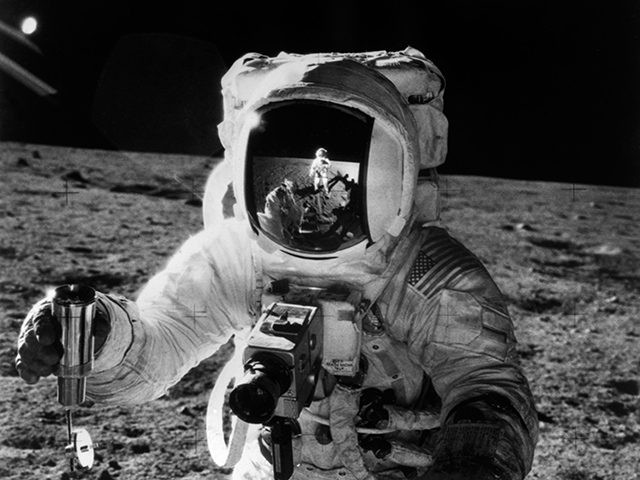Nov. 14 (UPI) — The 50-year anniversary of the Apollo 12 launch is reviving memories of how the United States made its first return to the moon.
During a time when NASA is striving to return again to the moon, Apollo 12 recalls the historic achievements of 1969. The second moon mission launched at 11:22 a.m. from Kennedy Space Center, Fla., on Nov. 14, 1969, four months after Apollo 11.
Besides the historic second moon landing — on Nov. 19 — Apollo 12 is known for surviving two lightning strikes moments after liftoff, and for sticking a “pinpoint landing” on the moon with little manual piloting.
Ike Rigell, a former chief engineer and launch director for NASA, remembers the moment Apollo 12 began its ascent into a cloudy, rain-swept sky.
“After liftoff, lightning struck around 30 seconds into the flight, and the telemetry and the instruments went haywire — none of it made sense,” Rigell, now 96, told UPI. “There had been some discussion about weather, but not much concern. That was when we learned never to launch near an anvil cloud in a storm.”
Apollo 12 landed on the moon Nov. 24, 950 miles from where Apollo 11 had landed. The new site had been chosen so that astronauts could walk to the remains of the Surveyor III spacecraft that had landed in 1967 in the vast Oceanus Procellarum, or Ocean of Storms.
Sticking that landing site closely gave NASA confidence to select future landing points in rough terrain of great scientific interest, according to an account from the Smithsonian National Air and Space Museum.
The Apollo 12 astronauts were Charles (Pete) Conrad, Jr., the commander, and Alan L. Bean, lunar module pilot, both of whom walked on the moon. Richard F. Gordon was the command module pilot. All three are deceased, with Bean the last to die in May 2018.
“Apollo 11 was primarily to just show we could do it, and then we kept advancing and finally put a moon buggy up there and other things,” said Rigell, who still lives in Florida just miles from the space center.
“I marvel at the success of Apollo more now than I did then. It was designed with 1960 technology; it was moving parts, stepping switches and inverters,” he said.
Another former engineer at the space center, Jim Ogle, said returning to the moon was an important statement, although the mission always was overshadowed by Apollo 11.
“The second mission was not as hyped, of course, but it was still significant,” said Ogle, 82, who also lives on the Space Coast. “It showed landing on the moon the first time wasn’t a fluke, and we did it again, and several more times.”
Ogle was a contractor working for defense and aerospace contractor McDonnell-Douglas at the time. He also recalls the lightning strike upon liftoff.
“It was a very overcast morning,” Ogle said. “They counted down and lifted off, and everyone was so excited. But a few seconds later, here comes a lightning strike. It was totally visible to everybody.”
With Apollo 11, the United States had won the Cold War space race against the Soviet Union, which diminished some of the urgency the nation felt, Ogle said.
“There were a lot of pink slips handed out immediately after Apollo 11 was accomplished,” Ogle said. “The Vietnam War was actually the reason. The moon program was competing for dollars and the tremendous support we’d had didn’t last for long.”
On Apollo 12, astronauts brought back pieces of the Surveyor spacecraft, which were studied for the impact of exposure to the lunar environment for more than 30 months.
NASA also studied lightning and its impact on launches, Rigell recalled.
“Kennedy Space Center went into an aggressive program to evaluate the weather impact on launches, and trying to understand lightning,” Rigell said. “The lightning towers that surround launch pads today are a result of that.”
Apollo 12 set the stage for the star-crossed Apollo 13 mission, which suffered a malfunction and explosion on the way to the moon and had to turn back.
Rigell recalls NASA legend Rocco Petrone cautioning him and other engineers to never get complacent about a rocket. “He told us, that rocket out there today doesn’t know that previous rockets were a success,” Rigell said.
Rigell has since written a memoir published by Koehler Books about his time in the Pacific during World War II and his career at NASA. He will speak at an event marking Apollo 12 on Nov. 23 at the American Space Museum in Titusville, Fla.
Another legacy of Apollo 12 still is orbiting the Earth occasionally, according to NASA. Due to incorrect data in trajectory commands, the agency says the third-stage booster missed a perfect sun-centered orbit and sometimes returns to Earth orbit. It was mistaken for an asteroid at one point and is now referred to by astronomers as object J002E3.

COMMENTS
Please let us know if you're having issues with commenting.